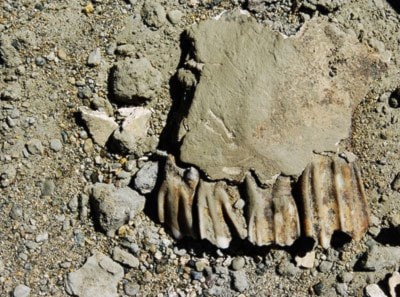It’s not very often that paleontologists find the fossils of prehistoric bison in southern Yukon.
It’s even more rare to find them at the bottom of an outhouse.
However, that’s exactly where an ice-aged bison jawbone was unearthed Tuesday.
“If I was going to stick my neck out, I’d say it’s around 10,000 years old,” said Yukon paleontologist Grant Zazula.
On Thursday, he was at his Whitehorse office. The jaw fragment sat in a box filled with sand, waiting to be sent away for radio-carbon dating.
Rolland and Mary Girouard discovered the newest specimens while digging the hole for their new outhouse.
Nearly finished with their 2.5-metre deep hole, Rolland took a few extra scoops with his shovel and found what looked to be a smooth skull and some teeth.
After he made some phone calls, three heritage branch employees arrived Monday afternoon.
An archeologist speculated that the remains might have been from an ice-age horse.
Zazula and Elizabeth Hall, a University of Alberta masters student, spent much of Tuesday morning unearthing the skull fragment.
They discovered that it belonged to an ancient bison, not a pygmy horse as originally predicted.
The fragment will be sent away for radio-carbon dating and it will be difficult to find out its age until then, said Zazula,
A rich, bloody, stew-like smell seeped into the warehouse through the back door where, just outside, a worker was boiling the meat off some modern-day bison bones.
The contemporary bison had to be put down and were donated to the paleontologists to use as a reference against the ancient bone fragments they find.
The northern bison lived in unglaciated areas during an ice age until about 10,000 years ago when plains bison from down south moved in and wiped them out.
These bison went extinct 300 years ago for unknown reasons, although many speculate that it could have been the result of over hunting.
Today’s Yukon bison were recently reintroduced.
In his enthusiasm Zazula would veer off topic and begin showing off other artifacts in his collection.
There was a woolly mammoth tooth that weighed 2.25 kilograms and was nearly the size of a human head.
He also held the skull of a prehistoric giant beaver, similar to the bucktoothed mammals we know today but the size of a black bear.
There are even some dinosaur footprints in the collection, although they require a little “geo-fantasizing” to make them out.
Most of the artifacts are from further north, near Dawson and Old Crow.
Miners find thousands of bones, which they set aside for paleontologists.
The majority of the bones come from bison.
“It’s good to have such a large sample set,” said Zazula.
“It helps us see how they evolved and adapted to climate change.”
The evidence might even provide clues as to how the current changes in the planet’s temperature will affect bison and other animals.
“It was nice to do a dig close to home,” said Zazula, who spends most of his time collecting from “dirty, mucky, remote places.”
“We’re really glad that they called us, we had a blast yesterday digging this thing out.”
Rolland also gave the territory another bone fragment that he had found while doing some work earlier.
He originally thought it belonged to a moose but it may be another section of the bison at the bottom of his biffy.
The paleontologist didn’t have to enlarge the hole too much, so the outhouse isn’t going to be the two-seater that Rolland speculated it might become.
But the hole is now deeper so the outhouse will last longer, he said.
